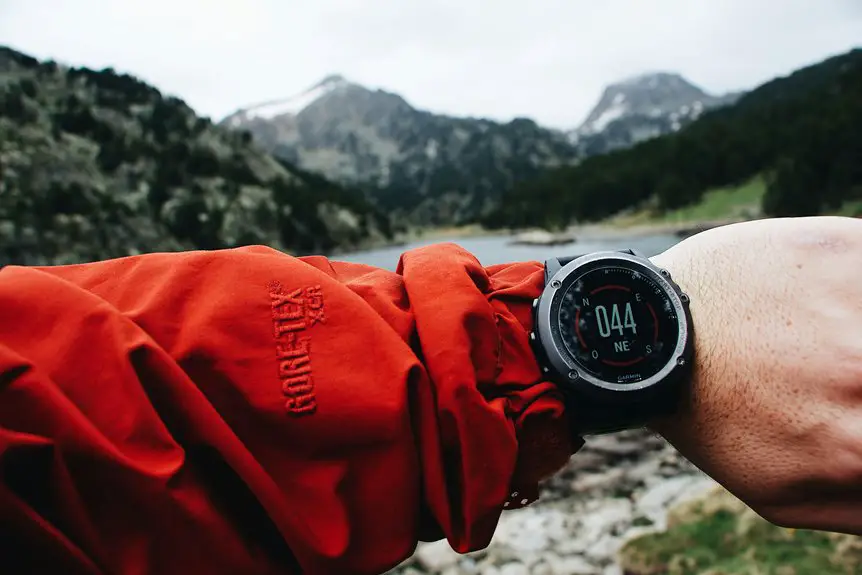You shouldn’t use wax on your Gore-Tex jacket because it can clog the membrane, cutting down breathability and waterproof performance. Wax treatments tend to stiffen the fabric and create uneven water resistance, which limits flexibility and comfort. Instead, go for specialized Durable Water Repellent (DWR) coatings designed for Gore-Tex. If you want your jacket to stay fully effective and last longer, it’s worth exploring better care and restoration options available to you.
Table of Contents
Key Takeaways
- Wax is not recommended for Gore-Tex jackets as it can clog membrane pores and reduce breathability.
- Wax treatments may stiffen the fabric and interfere with the jacket’s waterproof function.
- DWR coatings are specifically designed to maintain Gore-Tex breathability and water resistance.
- Spray-on or heat-activated DWR treatments are safer alternatives for restoring water repellency.
- Regular cleaning and proper DWR reapplication better preserve Gore-Tex jacket performance than waxing.
What Is Gore-Tex and How Does It Work?
Gore-Tex is a waterproof, breathable fabric membrane designed to keep you dry and comfortable in wet conditions.
When you wear a Gore-Tex jacket, its microscopic pores block water droplets from penetrating while allowing moisture vapor from sweat to escape. This means rain can’t get in, but sweat won’t get trapped, preventing that clammy feeling.
The membrane is bonded between your jacket’s outer fabric and inner lining, creating a barrier that balances protection and ventilation. You rely on Gore-Tex to perform during outdoor activities where weather changes quickly.
Its unique construction guarantees your jacket stays lightweight and flexible without sacrificing durability. Understanding how Gore-Tex works helps you appreciate why maintaining its functionality is essential for lasting performance.
The Role of Durable Water Repellent (DWR) Coating
You rely on the Durable Water Repellent (DWR) coating to keep your Gore-Tex jacket shedding rain and moisture.
Unlike wax, DWR is a lightweight, factory-applied finish that maintains breathability while repelling water.
Understanding how DWR compares to waxing helps you decide when and why to refresh your jacket’s water resistance.
Purpose of DWR
Although it might seem like a small detail, the Durable Water Repellent (DWR) coating plays an essential role in keeping your jacket effective against wet weather. It prevents water from soaking into the fabric, allowing droplets to bead up and roll off. Without DWR, your Gore-Tex jacket would lose breathability and become heavy when wet.
Here’s what DWR does for you:
| Benefit | Explanation |
|---|---|
| Water Resistance | Keeps the outer fabric dry and repels water |
| Breathability | Maintains airflow by preventing saturation |
| Durability | Extends jacket’s lifespan by reducing water damage |
Understanding DWR helps you appreciate why maintaining this coating is vital for your jacket’s performance.
DWR Vs Wax
Two common methods help keep your jacket water-resistant: Durable Water Repellent (DWR) coatings and wax treatments. Both have their strengths, but they serve different purposes for your Gore-Tex jacket.
- DWR Coating: Applied during manufacturing, DWR causes water to bead up and roll off, maintaining breathability.
- Wax Treatment: Adds a thicker, more durable barrier, but can reduce breathability and flexibility.
- Reapplication: DWR wears off over time and requires reapplication; wax can last longer but needs careful use to avoid clogging fabric pores.
- Suitability: DWR is designed specifically for Gore-Tex, while wax is better suited for heavy-duty outerwear like canvas.
You’ll want to choose based on your activity and the balance between water resistance and breathability you need.
How Wax Treatments Affect Waterproof Fabrics
When you apply wax to waterproof fabrics like Gore-Tex, it changes how the material handles water and breathability.
Wax creates a hydrophobic layer on the fabric’s surface, causing water to bead up and roll off more aggressively than traditional Durable Water Repellent (DWR) coatings. This can enhance water resistance temporarily, especially in heavy rain or wet snow.
However, because wax forms a thicker seal, it can also reduce the fabric’s ability to let moisture vapor escape. That means your jacket might feel less breathable, trapping sweat and heat inside during vigorous activities.
Wax treatments can also alter the fabric’s texture, making it stiffer or heavier.
Understanding these effects helps you decide if waxing suits your specific needs and conditions.
Potential Risks of Using Wax on Gore-Tex Jackets
Even if waxing can boost water resistance, you risk damaging your Gore-Tex jacket’s performance by applying it improperly.
Wax can clog the membrane’s microscopic pores, reducing breathability and making the jacket uncomfortable during physical activity. You might also create uneven patches that don’t repel water effectively. Over time, wax buildup can stiffen the fabric, decreasing its flexibility and durability.
Here are four potential risks to watch out for:
- Reduced Breathability: Wax blocks Gore-Tex’s ventilation, causing sweat to accumulate.
- Membrane Damage: Excess wax can interfere with the membrane’s waterproof function.
- Fabric Stiffness: Wax buildup stiffens the jacket, limiting movement.
- Uneven Water Resistance: Uneven application leads to inconsistent protection.
Use caution if you decide to wax your jacket.
Alternative Methods to Restore Water Repellency
If you want to restore your Gore-Tex jacket’s water repellency without using wax, you can try spray-on Durable Water Repellent (DWR) treatments.
These sprays are easy to apply and designed specifically for waterproof fabrics.
You might also consider heat-activated reproofing treatments that bond to the fabric when warmed, giving your jacket a fresh protective layer.
Spray-On Durable Water Repellent
Although wax can be effective, you might find spray-on durable water repellent (DWR) treatments easier to apply and better suited for restoring your Gore-Tex jacket’s water resistance.
These sprays penetrate the fabric without clogging the breathable membrane, maintaining comfort.
To use spray-on DWR effectively:
- Clean your jacket thoroughly to remove dirt and oils.
- Spray evenly from about 6-8 inches away, focusing on outer fabric.
- Let the jacket air dry completely before use.
- Reapply after several washes or when water stops beading.
Spray-on DWR treatments offer a quick, convenient way to renew water repellency without altering the jacket’s feel or breathability.
They’re an excellent alternative if you want hassle-free maintenance without the heaviness wax can add.
Heat-Activated Reproofing Treatments
When you want to restore your Gore-Tex jacket’s water repellency without applying heavy wax or frequent sprays, heat-activated reproofing treatments provide an effective solution. These treatments use heat to bond a durable water repellent (DWR) layer back onto the fabric, renewing its water-shedding ability. You usually apply the treatment by spraying or soaking, then activating it with a warm iron or tumble dryer. It’s quick, efficient, and keeps your jacket breathable.
| Feature | Details |
|---|---|
| Application Method | Spray or soak |
| Activation | Iron or tumble dry |
| Drying Time | 10-20 minutes |
| Breathability Impact | Minimal |
| Reproofing Frequency | Every 3-6 months (depending on use) |
This method avoids wax buildup and maintains fabric performance.
Proper Cleaning Techniques for Gore-Tex Jackets
Maintaining your Gore-Tex jacket begins with proper cleaning techniques that preserve its waterproof and breathable qualities.
Proper cleaning is key to preserving your Gore-Tex jacket’s waterproof and breathable performance.
To keep your jacket performing at its best, follow these steps:
- Use a gentle detergent – Avoid fabric softeners and bleach, which can damage the membrane.
- Machine wash cold – Use a front-loading washer on a gentle cycle to prevent fabric wear.
- Rinse thoroughly – Extra rinses help remove detergent residue that can clog pores.
- Air dry or tumble dry low – Heat reactivates the durable water repellent (DWR) finish without harming the membrane.
When and How to Reapply DWR Coating
Since the durable water repellent (DWR) coating wears off over time, you’ll need to reapply it to keep your Gore-Tex jacket water-resistant. Check for signs like water soaking in instead of beading. Reapply after several washes or when water resistance fades.
Here’s a simple guide:
| Step | Action |
|---|---|
| 1. Clean | Wash jacket with tech cleaner |
| 2. Dry | Tumble dry or air dry |
| 3. Apply DWR | Spray or soak treatment |
| 4. Heat Activate | Tumble dry or iron (low heat) |
| 5. Test | Check water beading |
Follow these steps to restore your jacket’s performance efficiently.
Tips for Maintaining Long-Lasting Waterproof Performance
To keep your Gore-Tex jacket performing at its best, you’ll want to adopt a few simple habits that protect its waterproof qualities.
Regular care guarantees your jacket stays breathable and water-resistant for years.
Consistent maintenance ensures your jacket remains breathable and water-resistant for many seasons to come.
- Clean it regularly — Use a gentle detergent and warm water to remove dirt and oils that clog pores.
- Reapply DWR coating — When water stops beading, refresh the durable water repellent to maintain surface water resistance.
- Avoid fabric softeners — These can damage the membrane and reduce breathability.
- Store properly — Hang your jacket in a cool, dry place to preserve its shape and membrane integrity.
Follow these tips to extend your Gore-Tex jacket’s life without relying on wax treatments that can harm its performance.
Frequently Asked Questions
Can Waxing a Gore-Tex Jacket Affect Its Breathability?
Waxing your Gore-Tex jacket can reduce its breathability by clogging the membrane’s pores. You’ll trap moisture inside, making it less effective. So, avoid waxing to keep your jacket breathable and performing well.
Is Waxing a Gore-Tex Jacket Safe for All Jacket Colors?
About 70% of outdoor enthusiasts worry waxing might alter jacket colors. You shouldn’t wax all Gore-Tex jackets—darker colors usually handle it better, while lighter ones risk discoloration. Always test a small area first!
How Long Does a Wax Treatment Last on Gore-Tex Fabric?
A wax treatment on Gore-Tex usually lasts a few months, depending on wear and environmental exposure. You’ll need to reapply when you notice water no longer beads up or the fabric feels less water-resistant.
Can I Use Any Type of Wax on My Gore-Tex Jacket?
You shouldn’t use just any wax on your Gore-Tex jacket. Only specialized, breathable waxes designed for waterproof fabrics work well, preserving breathability and water resistance without damaging the membrane. Always check product labels carefully.
Will Waxing a Gore-Tex Jacket Change Its Texture or Feel?
Waxing your Gore-Tex jacket can change its texture, making it feel stiffer and less breathable. It might also alter the fabric’s softness and flexibility, so you’ll notice a different feel compared to its original state.
- What Is Textured Bouclé? a Deep Dive Into the Fabric’s Feel - July 3, 2025
- What Is Jute Bouclé? a Natural and Textured Rug Option - July 3, 2025
- What Is Italian Bouclé Wool? the Premium Fabric Explained - July 3, 2025







